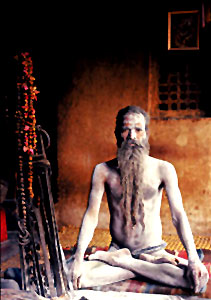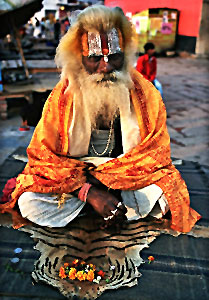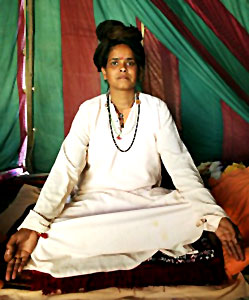Sadhus in Hinduism are referred to religious ascetics or holy men. Sadhus are the people who lead a disciplined life. They are said to be Yogis as they are the practitioner of yoga. The Sadhus have restricted themselves from `kama` or pleasure, `artha` or practical objectives and `dharma` or duty.
The Sadhu entirely dedicates his life in attaining liberation or moksha or nirvana. The Sadhu attains moksha through meditation and contemplation of the Supreme God. Thus the Sadhus most often are seen wearing saffron or yellow ochre colour dresses which symbolize rejection of worldly pleasures.
Sadhu is a Sanskrit word which means good man and who have chosen to live a life secluded from the society and earthly contentment in order to focus on religious practice. The word Sadhu is originated from Sanskrit word `sadh` which means `to reach one`s goal`, `make straight` and `gain control over oneself`
Sadhus are also known as `swami` or `sanyasi` as they are persons who have left over all material and sexual attachments and reside in caves, forests and temples situated all over India. Sadhus may perhaps live together in monasteries that usually belong to a particular order. They may also roam throughout the country alone or in small groups or detach themselves in small huts or caves. The Sadhus also take vows of poverty and depend on the charity of people for their food. The dresses and ornaments worn by the Sadhus differ from what the normal person wear. The Sadhus are usually seen wearing yellow ochre or white robes, and some are even naked, known as `Naga Sanyasi`. They are also seen with shaved heads, or they allow their hair to grow till shoulder length or curl it into a knot on top of their heads. They have very belongings like they carry a staff or `danda`, a water pot or `kamandalu`, an alms bowl, prayer beads, and perhaps an extra cloth or a fire tong.
 Some more details on the lifestyle lead by the Sadhus are that they are not always united in their practices. Some of them live in the mountains alone for years at a time, eating only a few bananas. Some Sadhus walk around with one hand in the air for many years until the fingers withdraw into a stump. Some of them consume charas, that is the preparation of ganja and contemplate the cosmic nature and presence of God in the smoke patterns.
Some more details on the lifestyle lead by the Sadhus are that they are not always united in their practices. Some of them live in the mountains alone for years at a time, eating only a few bananas. Some Sadhus walk around with one hand in the air for many years until the fingers withdraw into a stump. Some of them consume charas, that is the preparation of ganja and contemplate the cosmic nature and presence of God in the smoke patterns.
There are also naked Naga Sadhus or Sanyasis who are distinct for their thick dreadlocks, non-shaven, and Jata and carry swords. There are also Aghora Sadhus who keep company with ghosts, or live in cemeteries as part of their holy path.
Sometimes a Sadhu is referred as `Baba` by common people. Often the respectful suffix `ji` may also be added after `Baba`, to give greater respect to the word `Babaji`.
There are about five million Sadhus found in India. They are usually respected for their sanctity and religiousness and sometimes feared for their curses. In Hinduism it is believed that the austere practices of the Sadhus help to burn off their karma and that of the community at large.
 Sadhus are divided into two sects or divisions; they are Shaiva Sadhus and the Vaishnava Sadhus. Shaiva Sadhus are ascetics devoted to the Lord Shiva, and Vaishnava Sadhus are the religious disciples devoted to the Lord Vishnu and various his incarnations, like Rama and Krishna. Some of the Sadhus are dedicated to the Goddess Shakti, the divine source of energy and is known as Shakta Sadhus.
Sadhus are divided into two sects or divisions; they are Shaiva Sadhus and the Vaishnava Sadhus. Shaiva Sadhus are ascetics devoted to the Lord Shiva, and Vaishnava Sadhus are the religious disciples devoted to the Lord Vishnu and various his incarnations, like Rama and Krishna. Some of the Sadhus are dedicated to the Goddess Shakti, the divine source of energy and is known as Shakta Sadhus.
The Shaiva Sadhus are largest Shaiva in number and is called the Dashanami or Ten Names. The sages belonging in this sect take one of the ten names as a designation upon initiation. The sect was formed by Shankara, the philosopher and renunciant. Shankara is believed to have lived in the eighth century.
The Vaishnava sect with the greatest number of members, is the Ramanandi sect. This sect of Sadhus was founded by Ramananda, the great medieval teacher of Bhakti, or devotion.
The Shaiva Sadhus are called `sanyasis`, and on the contrary the Vaishnava Sadhus are called `vairagis`. The philosophy of Shaiva followers are asceticism and repudiation. The methods followed by the Shaiva Sadhus are austere and radical than that of the Vaishnavas. The Shaivism give importance to the radical separation from the conventional social life and fully indulges in the liberation from `Samsara`, that is the cycle of birth and death. Whereas Vaishnavas emphasizes in the non-Sadhu social world through compassionate service
 In Hinduism there are female Sadhus, known as Sadhvis. The widows take the life of the female Sadhus. They also live a secluded life in ascetic compounds. Sadhvis are regarded as forms of the Goddess, or Devi, and honored in that position. There have been a number of enigmatic sadhvis that have risen to fame as religious teachers in India.
In Hinduism there are female Sadhus, known as Sadhvis. The widows take the life of the female Sadhus. They also live a secluded life in ascetic compounds. Sadhvis are regarded as forms of the Goddess, or Devi, and honored in that position. There have been a number of enigmatic sadhvis that have risen to fame as religious teachers in India.
In Hinduism it is believed becoming a Sadhu is very difficult. It is supposed to be the fourth phase of life of men. The austerities of the Sadhu life prevent many people from following the Sadhu path. The Sadhus bath early morning in the morning in the cold mountains requires and detached themselves from common luxuries. After the bath, Sadhus gather around the holy fireplace, and begin with their prayers and meditation for the day.
The Kumbha Mela in India is a place where a numerous number of Sadhus from all parts of India gather here. The Kumbha Mela takes place every three years at one of four points along sacred rivers in India, Allahabad, Haridwar, Ujjain and Nashik.



















